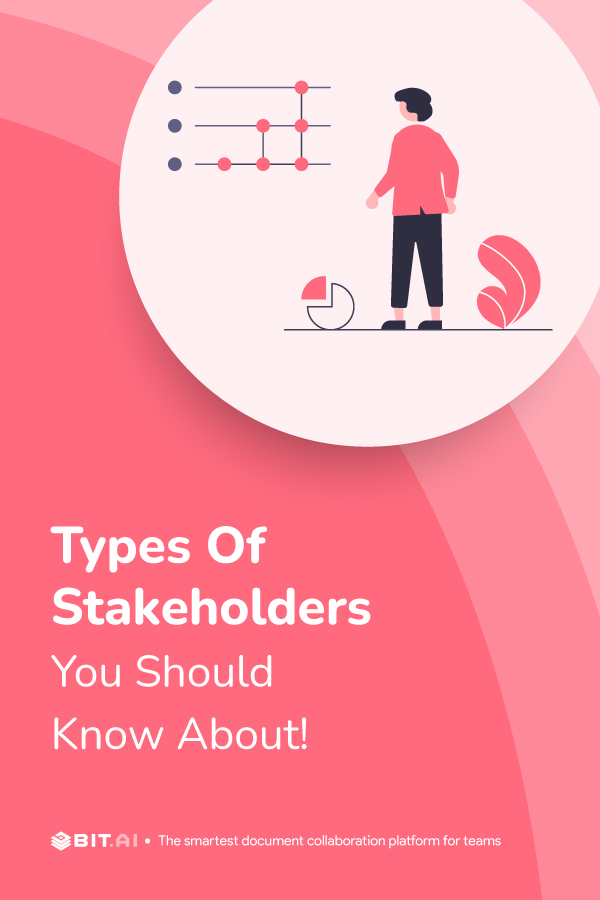No project ever happens in isolation. No matter how big or small, it involves individuals and groups. It’s not just you; a whole bunch of folks care about what’s going on in your business. These folks are known as stakeholders. They’re the ones who have a personal or financial interest in what you’re doing.
Stakeholders come in all shapes and sizes. Investors, customers, and even your employees can be stakeholders. They’re the ones who can be affected, for better or worse, by what your business does.
So, what kinds of stakeholders are there?
That’s the question we’ll dive into. Whether it’s the people investing money or the ones buying your products, stakeholders play a big role in any project.
What is a Stakeholder?
A stakeholder is someone or a group who cares about what a company or project is doing. They can be part of the company or not. These people can have a big say in what happens and whether things go well.
Imagine you’re in a race, like a horse race. The people who own the horses pay some money to join the race. This money is like a ‘stake,’ which means a risk. The stakeholder is the person who looks after this money until the race is over. But this person doesn’t care who wins; they want to ensure everything is fair.
In a business or project, a stakeholder is like that person. They might not own the company but care about how it does. It could be customers, workers, investors, or even the government. These people can help or hurt the company with their choices.
3 Main Categories of Stakeholders
Stakeholders in a business can be grouped into three main categories: internal or external, primary or secondary, and direct or indirect.
- Internal or External
- Primary or Secondary
- Direct or Indirect
1. Internal or External Stakeholders
Internal Stakeholders: These are folks inside the organization, directly affected by the business and its projects. These types of stakeholders include employees, owners, the board of directors, project managers, and investors.
External Stakeholders: These are people outside the organization, influenced by the business but not employees. Examples of these types of stakeholders include customers, suppliers, government agencies, and communities.
Read more: Stakeholder Mapping: Definition, Importance, Process & Tools!
2. Primary or Secondary Stakeholders
Primary Stakeholders: These are the key players with the highest interest in the project’s outcome. They actively contribute to the project. Examples include customers and team leaders.
Secondary Stakeholders: They also help with projects on a lower, general level, like administrative processes. Examples are governments and trade unions.
3. Direct or Indirect Stakeholders
Direct Stakeholders: These types of stakeholders are involved in day-to-day project activities, like employees who work directly on projects.
Indirect Stakeholders: They focus on the project’s finished outcome rather than its process, like customers who care about the product’s quality and price.
9 Main Types of Stakeholders
- Customers
- Employees
- Investors
- Owners
- Suppliers and Vendors
- Communities
- Trade Unions
- Government Agencies
- Media
1. Customers
Customers are the cornerstone of a business. They’re the individuals or organizations that buy the company’s products or services. Their preferences, satisfaction, and loyalty are vital for a business’s prosperity. It is essential to meet their expectations, which usually involve receiving high-quality goods or services at a fair price. A satisfied customer is likely to make repeat purchases and can also become an advocate, spreading positive word-of-mouth and attracting new customers.
2. Employees
Employees are the heart of any organization. They are the ones who work directly for the business, managing daily operations and interacting with customers. Their commitment and performance are critical for the success of the business. While they expect fair financial compensation, job security, and career advancement opportunities, their job satisfaction also plays a significant role. Happy and motivated employees tend to be more productive and contribute positively to the work environment.
3. Investors
Investors are individuals or groups who provide financial resources to the business. This types of stakeholders do so with the expectation of generating a profit on their investment. Beyond funding, they can offer valuable insights, advice, and networking connections, aiding the company’s growth and success. Investors can significantly influence the business’s direction and strategy, especially if they hold substantial stakes in the company.
4. Owners
Business owners have a unique position as they own and have a substantial stake in the company. This types of stakeholders provide initial capital and often have the authority to make key decisions that impact the business’s operations, including major strategic choices. Owners may include sole proprietors, partners, or shareholders in the case of a publicly traded company.
5. Suppliers and Vendors
Suppliers and vendors are external entities that are critical to the business’s supply chain. They provide the necessary materials, products, or services that the company needs to operate and deliver to its customers. These external partners rely on the business for revenue, mutually benefiting their relationship. Suppliers and vendors bring essential resources, expertise, and reliability to the business.
6. Communities
Local communities are indirectly impacted by the presence and performance of a business within their area. Businesses contribute to the community by creating jobs, fostering economic development, and potentially supporting local initiatives. Conversely, a failing business can have adverse effects, leading to job losses and a decline in the local economy. Therefore, businesses must consider their impact on the community as part of their corporate responsibility.
7. Trade Unions
Trade unions represent the interests of workers within a specific industry. They negotiate on behalf of employees to secure fair wages, safe working conditions, and other benefits. These organizations are external stakeholders but have an essential role in safeguarding the rights and well-being of the workforce.
8. Government Agencies
Government agencies oversee various aspects of business operations. They collect taxes, issue licenses, and regulate activities to ensure compliance with laws and regulations. These agencies also play a crucial role in protecting the interests of the broader community and the environment by enforcing standards and regulations.
9. Media
The media acts as a bridge between businesses and the public. They help companies advertise their products or services, reaching a broader audience. Additionally, the media serves as a platform for businesses to make important announcements, share news, and manage their public image. Maintaining positive relationships with the media can enhance a business’s reputation and visibility in the market.
Let’s Categorize The Types of Stakeholders Based On Their Characteristics
| Stakeholder | Internal/External | Primary/Secondary | Direct/Indirect |
|---|---|---|---|
| Customers | External | Primary | Direct |
| Employees | Internal | Primary | Direct |
| Investors | External | Primary | Direct |
| Owners | Internal | Primary | Direct |
| Suppliers and Vendors | External | Secondary | Indirect |
| Communities | External | Secondary | Indirect |
| Trade Unions | External | Secondary | Indirect |
| Government Agencies | External | Secondary | Indirect |
| Media | External | Secondary | Indirect |
Stakeholder Vs. Shareholder
Let’s clear up a common confusion – the difference between stakeholders and shareholders.
Stakeholders are people who have a keen interest in your business or project. However, they usually don’t have a financial stake in it. Think of them as folks who care deeply about what you’re doing, but they’re not investing money. Stakeholders can be a diverse group. They might include owners and even shareholders. But they can also be your employees, bondholders, customers, suppliers, and vendors. It’s a wide range.
Shareholders, on the other hand, have a financial interest in your business. They’re like partial owners because they invest their money in your company.
But here’s the twist: Shareholders are a subset of stakeholders. Why? Because when someone invests in your business, they automatically become a stakeholder, too. Their money speaks volumes in your company.
But why does this matter? Understanding the difference between these terms helps you figure out who to prioritize when making important decisions.
So, remember, stakeholders and shareholders are related but not the same. Stakeholders root for your success in diverse ways, while shareholders put their money on the line and want financial gains. Knowing this difference helps you navigate the complex world of business relationships.
What is Stakeholder Management?
Stakeholder management is key to making everyone happy while working on a project. Imagine you’ve been studying and understanding all the different types of people who care about your project. Now, it’s time to put that knowledge into action.
So, what is stakeholder management? Well, it’s like the process of keeping all these people happy and involved. It’s like making sure they’re heard without trying to trick anyone.
First, you need to figure out who these stakeholders are. That’s the first step. Then, you must consider what they want and expect from your project. This is important because it helps you plan how to work with them.
A good stakeholder management process helps you organize everything. It lets you see how well you’re getting along with these people and your relationship. It’s like a map that guides you in dealing with all these different groups.
Usually, people think of stakeholder management as making others do what they want. They create plans, put them on a shelf, and forget about them. But that’s not what we’re talking about here.
We don’t want to treat people like sheep and herd them in our desired direction. Instead, we want to work with them in a fair and helpful way.
Who is The Most Important Stakeholder?
You can’t make everyone happy. Different people, like employees and investors, are involved in a business, and they all want other things. But if you had to choose one group to make you happy, it should be your customers.
Why, you ask? Well, think about it – what’s a business without customers? It’s like a car without fuel; it just won’t go.
Well, because customers are the heart of a business. They’re the reason it exists. They’re the ones who provide jobs by buying stuff, and they’re the ones who trust the business with resources to make things. Customers can easily go to another business if they’re unhappy with yours. So, you need to be smart and offer good stuff that customers want.
So, while it’s tough to please everyone, the one stakeholder you should focus on is the customer. They’re the ones who make your business tick, and they’re the key to your success. So, if you want your business to do well, ensure your customers are happy. That’s the secret sauce.
Final Thoughts
Ultimately, stakeholders are like the different pieces of a puzzle in your project. You’ve got to understand who they are, what they want, and how to work with them. It’s not about pushing them around or ignoring their voices; rather, it’s about finding common ground.
But not all stakeholders are equal. Some are the VIPs of the show. To keep the project or business rolling smoothly, you’ve got to figure out who these key players are and what they need.
So, whether you’re in the race or running the show, it’s crucial to know your stakeholders, keep them in the loop, and ensure they’re content. After all, in the stakeholder game, keeping them happy is the winning move.
Good Luck!
Further Reads:
Customer Touch Points & How To Identify Them? (Examples & Tips)
Customer Needs: Most Common Types You Should Know About!
AIDA Model: How To Connect & Engage With Your Customers?
What is Customer Delight? Learn More!



